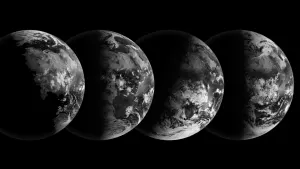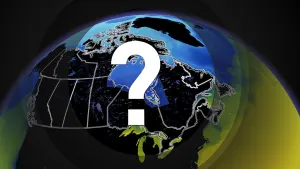
Tonight's Harvest Supermoon will be darkened by Earth's shadow
Supermoons are known for being extra bright, but Tuesday night's will be an exception, as it briefly darkens due to 'interference' from Earth.
Eyes to the sky tonight, to see the Harvest Supermoon pass through the edge of Earth's shadow, resulting in a partial lunar eclipse.
The Full Moon rises with the setting Sun on the night of September 17, and it will be up in the sky for the entire night, setting as the Sun rises Wednesday morning.
The September Full Moon is traditionally called the Corn Moon. As this is the Full Moon nearest to the Fall Equinox, it is also 2024's Harvest Moon. Additionally, it is a supermoon — the closest and brightest Full Moon so far this year, in fact, second only to the upcoming October Hunter's Supermoon.

2024's four supermoons compared to a more 'typically' sized Full Moon from earlier in the year. (NASA's Scientific Visualization Studio/Scott Sutherland)
Although it's often difficult to tell with the unaided eye that a supermoon is bigger than other Full Moons of the year, one way they do distinguish themselves is through their brightness.
According to retired NASA scientist Fred Espenak, Tuesday night's Supermoon will be about 15 per cent brighter than your typical Full Moon (say, from June 22, as shown in the image above), and nearly 30 per cent brighter than one of the year's micromoons (from February or March).
A shadow across the Moon
Supermoons may be known for their brightness, but this one isn't going to stay bright the entire night.
The September 17 Full Moon will start off the night looking fairly normal across Canada. We should get a nice view of the famous Moon illusion, at the very least.
READ MORE: What is the mysterious Moon Illusion?
Then, as the night progresses, it will be as if someone was turning down a cosmic dimmer switch on the Moon's brightness, followed by a dark shadow slowly passing across the Moon's north polar region. This is the shadow of our planet, although the Sun, Earth and Moon are not lined up well enough to produce a 'blood moon' total lunar eclipse. The Moon will still dip into the 'lower' edge of the shadow, though, resulting in a partial lunar eclipse.

This idealized view of the September 17-18 partial lunar eclipse was made using an image of the Moon from NASA's Lunar Reconnaissance Orbiter, along with a simulation of the effects of this Full Moon passing through the edge of Earth's shadow. (NASA's Scientific Visualization Studio/Scott Sutherland)
The dark umbra of Earth's shadow has a dusky red colour — the product of the Sun's rays passing through Earth's atmosphere before being focused on the Moon.
With only a small portion of the Moon encountering the umbra, though, the red colour may be difficult to see contrasted against the rest of the lunar surface. If you happen to have a pair of binoculars or telescope, take a closer look, to see if you can spot the red.
Eclipse timing
The entire eclipse — from the moment the Moon makes contact with the outer part of Earth's shadow (the penumbra), until it exits out the other side — will last just over 4 hours. Since the effects of the penumbra are challenging to notice with the unaided eye, the best time to watch the event is during the middle part, when the Moon partly dips into the darker umbra for just over an hour.

The path of the September 17-18 Full Moon takes it across Earth's double-layered shadow, just skimming along the lower edge, plunging only the lunar north pole into darkness. (NASA's Scientific Visualization Studio/Scott Sutherland)
The eclipse start, end, and best viewing times, for different time zones across Canada, are shown in the table below:
NDT: 10:11 p.m. to 2:17 a.m., best from 11:44 p.m. to 12:46 a.m.
ADT: 9:41 p.m. to 1:47 a.m., best from 11:14 p.m. to 12:16 a.m.
EDT: 8:41 p.m. to 12:47 a.m., best from 10:14 p.m. to 11:16 p.m.
CDT: 7:41 p.m. to 11:47 p.m., best from 9:14 p.m. to 10:16 p.m.
MDT: 6:41 p.m. to 10:47 p.m., best from 8:14 p.m. to 9:16 p.m.
PDT: 5:41 p.m. to 9:47 p.m., best from 7:14 p.m. to 8:16 p.m.
Other sights in the sky
While you are out observing the Moon, take a glance around to potentially spot other bright celestial objects in the sky.
Just to the right/west of the Moon will be the planet Saturn, which rose before the Moon crested the horizon.
The ringed world is not as bright as it could be right now, even having just passes through Opposition (it's closest to Earth for 2024). That's because its rings are in the process of 'disappearing' — not permanently, mind you. We're coming up on a "ring-crossing event" in early 2025, where the planet's thin rings will appear to completely vanish as we only see them edge-on. Still, it should be bright enough to see, even in light-polluted skies.

Saturn, the Full Moon, Jupiter, and Mars line up across the sky on the night of September 17, 2024. (Stellarium)
READ MORE: Saturn's rings will 'disappear' by early 2025
Towards the end of the eclipse, Jupiter will be rising in the east, and it will be followed by Mars about an hour and 15 minutes later. While Jupiter will be easy to spot, Mars may present more of a challenge. Both planets will be getting brighter throughout the coming Fall season, though, as they each draw nearer to their own Oppositions (Jupiter in early December and Mars in mid-January).
DON'T MISS: The Fall 'Season of Meteor Showers' may include rare astronomical treats










